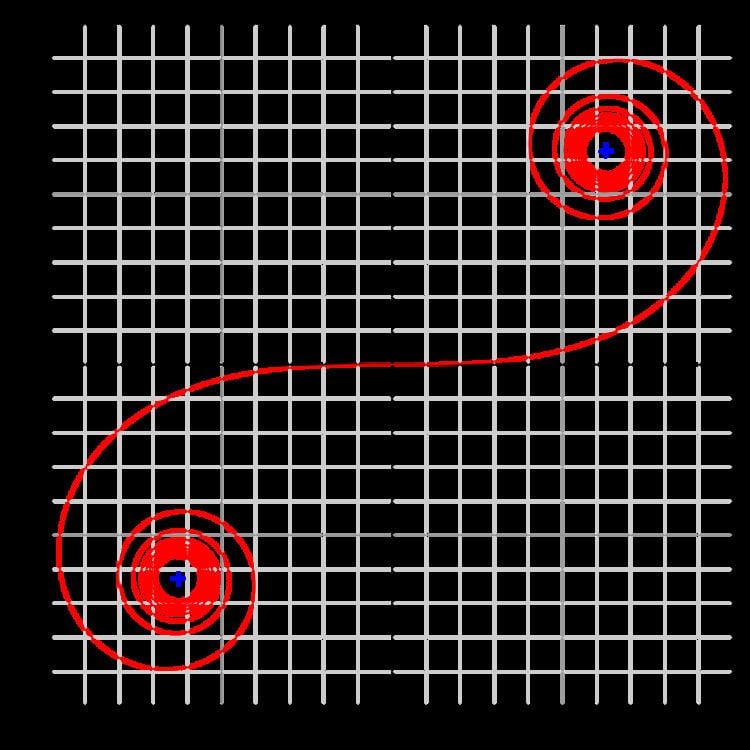 | ||
An Euler spiral is a curve whose curvature changes linearly with its curve length (the curvature of a circular curve is equal to the reciprocal of the radius). Euler spirals are also commonly referred to as spiros, clothoids, or Cornu spirals.
Contents
- Track transition curve
- Optics
- Integrated optics
- Auto Racing
- Expansion of Fresnel integral
- Normalization and conclusion
- Illustration
- Other properties of normalized Euler spirals
- Code for producing an Euler spiral
- References
Euler spirals have applications to diffraction computations. They are also widely used as transition curve in railroad engineering/highway engineering for connecting and transiting the geometry between a tangent and a circular curve. A similar application is also found in photonic integrated circuits. The principle of linear variation of the curvature of the transition curve between a tangent and a circular curve defines the geometry of the Euler spiral:
Track transition curve
An object traveling on a circular path experiences a centripetal acceleration. When a vehicle traveling on a straight path suddenly transitions to a tangential circular path, it experiences a sudden centripetal acceleration starting at the tangent point; and this centripetal force acts instantly causing much discomfort (causing jerk).
On early railroads this instant application of lateral force was not an issue since low speeds and wide-radius curves were employed (lateral forces on the passengers and the lateral sway was small and tolerable). As speeds of rail vehicles increased over the years, it became obvious that an easement is necessary so that the centripetal acceleration increases linearly with the traveled distance. Given the expression of centripetal acceleration V² / R, the obvious solution is to provide an easement curve whose curvature, 1 / R, increases linearly with the traveled distance. This geometry is an Euler spiral.
Unaware of the solution of the geometry by Leonhard Euler, Rankine cited the cubic curve (a polynomial curve of degree 3), which is an approximation of the Euler spiral for small angular changes in the same way that a parabola is an approximation to a circular curve.
Marie Alfred Cornu (and later some civil engineers) also solved the calculus of Euler spiral independently. Euler spirals are now widely used in rail and highway engineering for providing a transition or an easement between a tangent and a horizontal circular curve.
Optics
The Cornu spiral can be used to describe a diffraction pattern.
Integrated optics
Bends with continuously varying radius of curvature following the Euler spiral are also used to reduce losses in photonic integrated circuits, either in singlemode waveguides, to smoothen the abrupt change of curvature and coupling to radiation modes, or in multimode waveguides, in order to suppress coupling to higher order modes and ensure effective singlemode operation. A pioneering and very elegant application of the Euler spiral to waveguides had been made as early as 1957, with a hollow metal waveguide for microwaves. There the idea was to exploit the fact that a straight metal waveguide can be physically bent to naturally take a gradual bend shape resembling an Euler spiral.
Auto Racing
Motorsport author Adam Brouillard has shown the Euler spiral's use in optimizing the racing line during the corner entry portion of a turn.
Expansion of Fresnel integral
If a = 1, which is the case for normalized Euler curve, then the Cartesian coordinates are given by Fresnel integrals (or Euler integrals):
Expand C(L) according to power series expansion of cosine:
Expand S(L) according to power series expansion of sine:
Normalization and conclusion
For a given Euler curve with:
or
then
where
The process of obtaining solution of (x, y) of an Euler spiral can thus be described as:
In the normalization process,
Then
Generally the normalization reduces L' to a small value (<1) and results in good converging characteristics of the Fresnel integral manageable with only a few terms (at a price of increased numerical instability of the calculation, esp. for bigger
Illustration
Given:
Then
And
We scale down the Euler spiral by √60,000, i.e.100√6 to normalized Euler spiral that has:
And
The two angles
Other properties of normalized Euler spirals
Normalized Euler spirals can be expressed as:
Or expressed as power series:
The normalized Euler spiral will converge to a single point in the limit, which (noting that
Normalized Euler spirals have the following properties:
And
Note that
Code for producing an Euler spiral
The following SageMath code produces the second graph above. The first four lines express the Euler spiral component. Fresnel functions could not be found. Instead, the integrals of two expanded Taylor series are adopted. The remaining code expresses respectively the tangent and the circle, including the computation for the center coordinates.
The following is Mathematica code for the Euler spiral component (it works directly in wolframalpha.com):
The following is Xcas code for the Euler spiral component:
plotparam([int(cos(u^2),u,0,t),int(sin(u^2),u,0,t)],t,-4,4)The following is SageMath code for the complete double ended Euler spiral:
The following is JavaScript code for drawing an Euler spiral on a canvas element:
